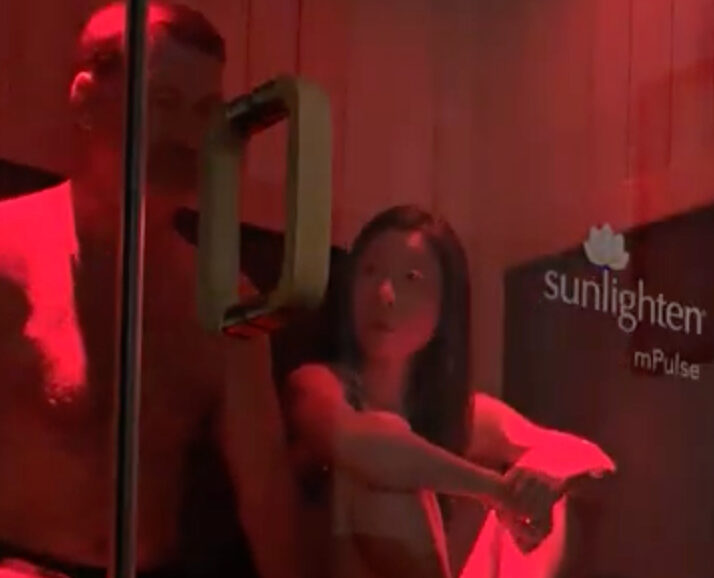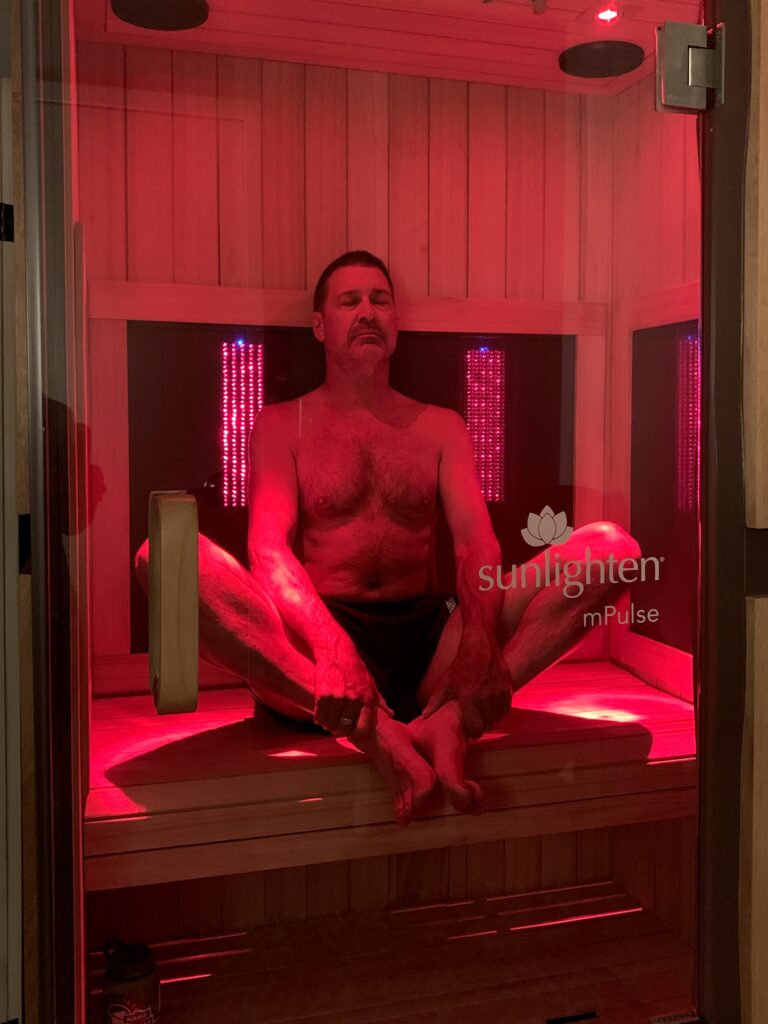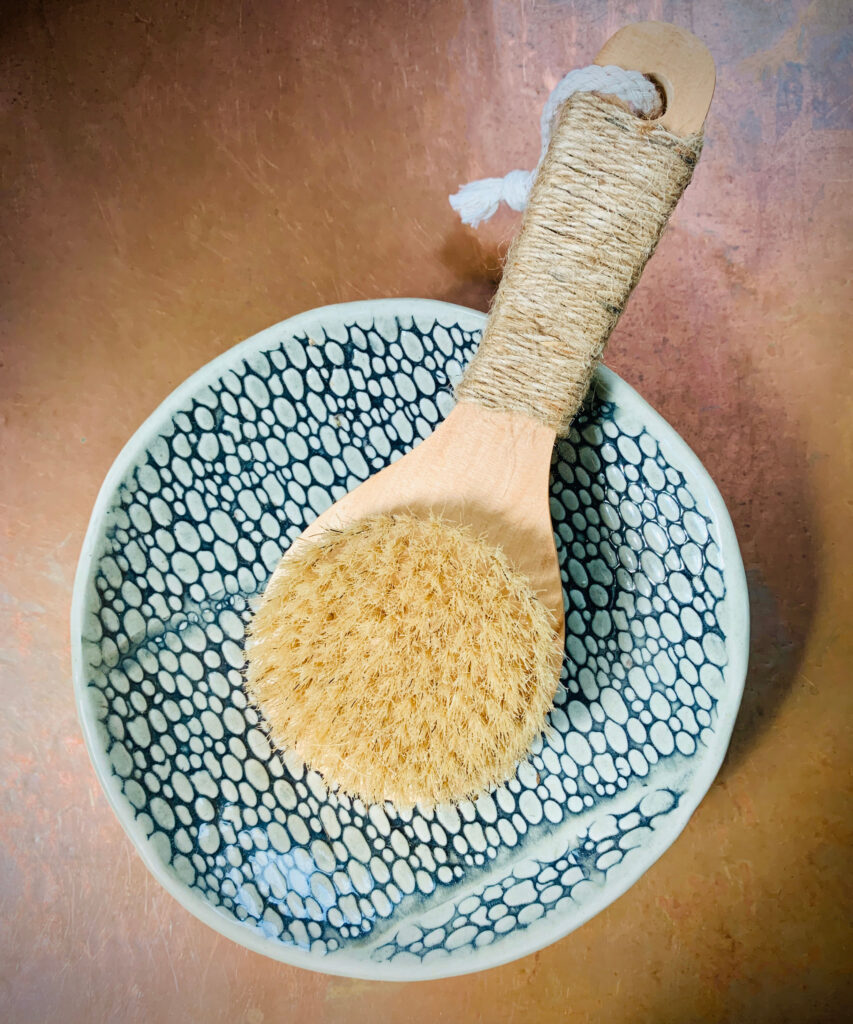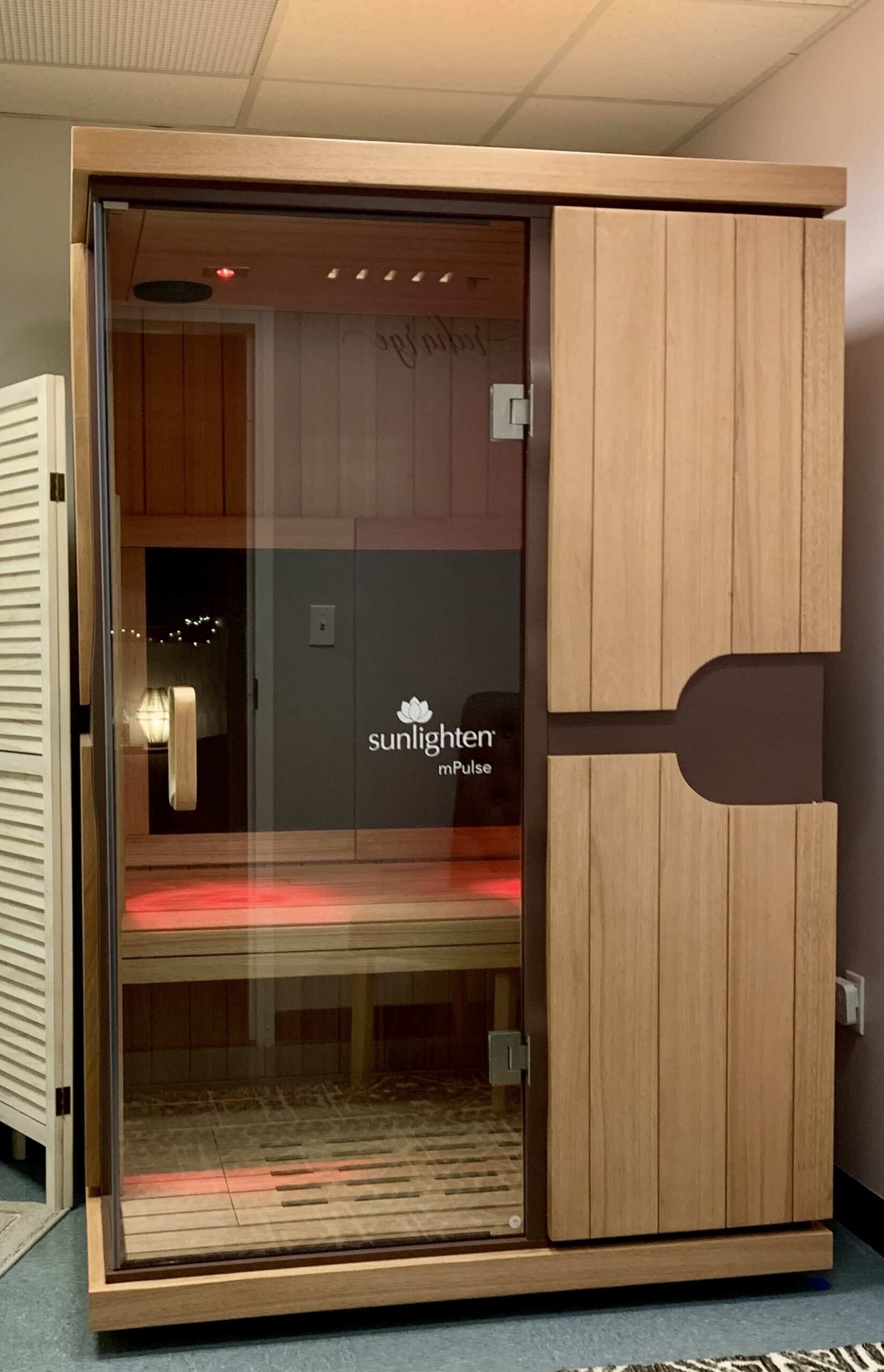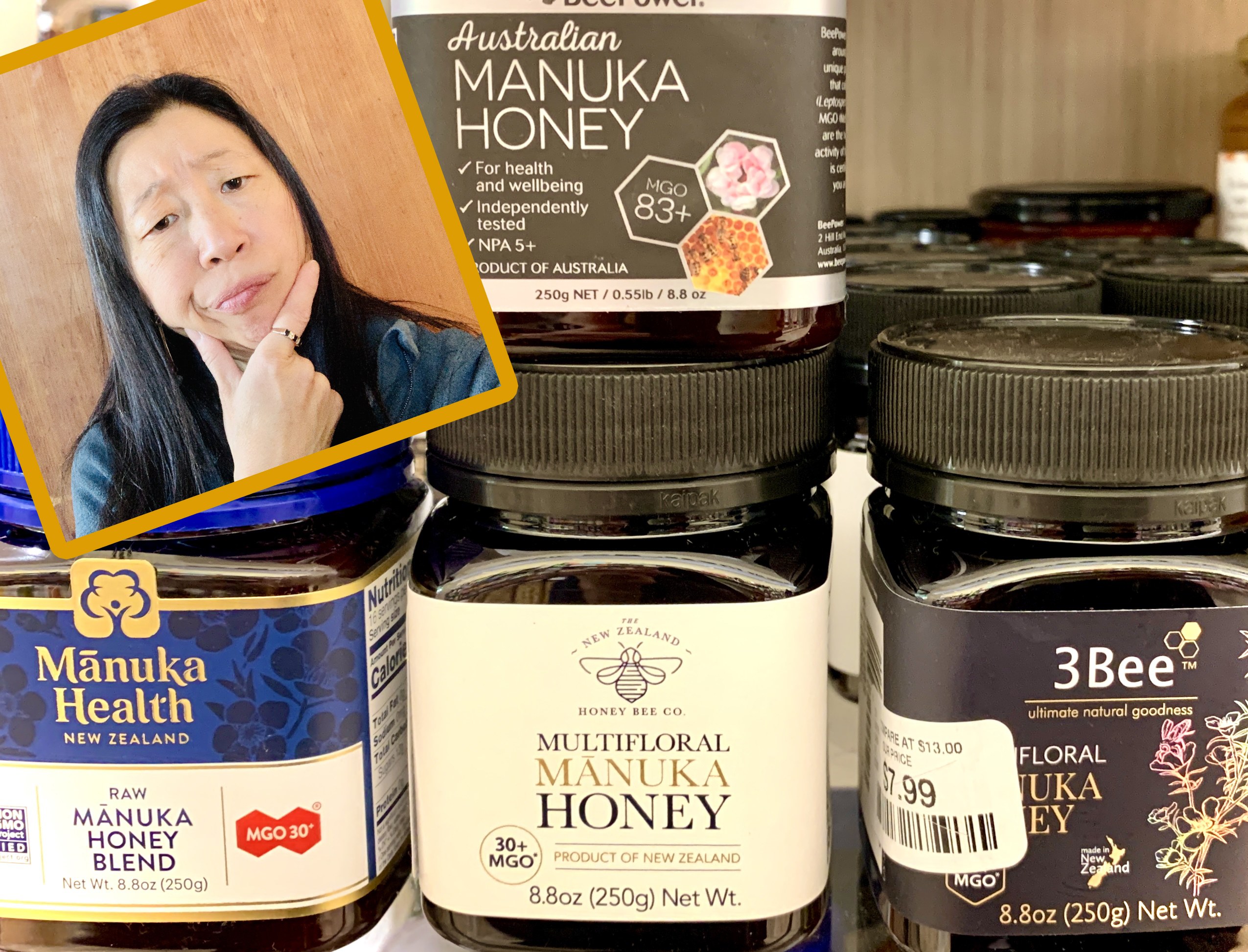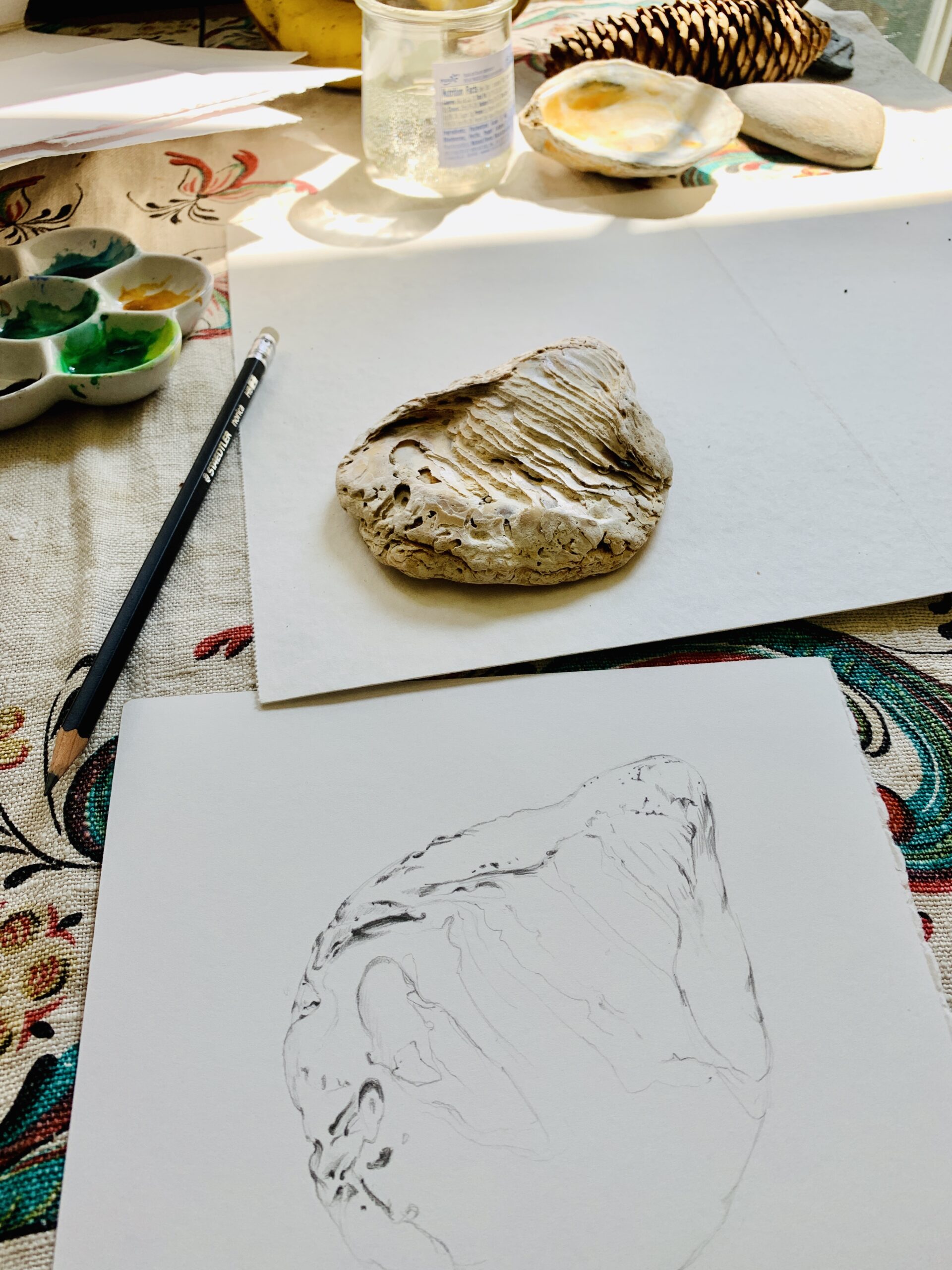What is it and why is it good for you?
We are light-filled beings, so it makes a lot of sense to harness light to assist with our health and wellness goals. But, you may be thinking that there are too many shiny objects vying for your attention, and wondering if the infrared sauna trend is just another flash in the pan? This post was written with your curiosity and wellness in mind, and my hope is that it will give you some insight into the benefits and healing power of infrared saunas.
Since we’re talking about infrared saunas, let’s get specific about the light being used. Remember when we learned about the light spectrum in fourth grade? If not, no matter, we’ll just review right now that all electromagnetic radiation is light, but humans can only see the narrow ROYGBIV spectrum. Within this visible spectrum, red has the longest (~700 ㎚) wavelength, and violet has the shortest (~380 ㎚). Red light therapy is often talked about with infrared sauna but they are different and here’s how.
Infrared saunas are electronic devices that emit electromagnetic frequencies (EMFs). The wavelengths of infrared sauna are around 800 ㎚ – 1000 ㎚ which are a smidge longer than red light, therefore they are just beyond our visibility. Remember I just mentioned above that visible red light has a wavelength of ~700 ㎚? Well, red light does offer health benefits, primarily for anti-inflammatory and antioxidant applications, but it is not the primary focus of this conversation today.

Oh, and since we were just talking about tiny increments of light, I just want to mention here that apart from releasing energy and producing heat, human bodies emit small amounts of particles of light, known as photons. We literally emit light though it is undetectable to the human eye.1
And now back to infrared light. These invisible waves are further divided into different bands of infrared: Near-infrared or luminous (760-1400 ㎚) uses incandescent bulbs, Mid-infrared (1400-3000 ㎚), and Far-infrared or non-luminous (3000 ㎚- 100,000 ㎚) uses ceramic or metal heating elements. Far-infrared light is capable of penetrating the body by about 4 cm beneath the skin where it can elicit a host of health benefits. It is this range of infrared light that we will talk mostly about for the rest of this post.
Just before we talk about health benefits of infrared light, now’s a good time to quickly discuss the teeny tiny units of measure we use to talk about wavelengths of light. When talking about infrared light, we use small metric units called micrometers (㎛) and nanometers (㎚). Put simply, one micrometer equals 1000 nanometers. When we talk about electromagnetic fields (EMFs), we use miligauss (mG), which I’ll mention again a little later when I tell you what type of sauna I use.

But wait, what about EMFs? Aren’t they bad for you?
If you can’t be bothered with a quick science report, skip ahead to how infrared saunas work.
EMFs are electric and magnetic fields created by anything that generates, distributes or uses electricity, that includes our own earth’s atmosphere (charged by lightning strikes). There are two distinctions when it comes to energy output of EMFs and they are, non-ionizing radiation (NIR) and ionizing radiation (IR).
Non-ionizing radiation has a longer wavelength and a lower frequency, thus considered relatively safe. NIR includes the spectrums of ultraviolet (UV), visible light, infrared (IR), microwave(MW), radio (RF) and extremely low frequency (ELF). Common sources of this type of radiation include microwaves, GPS devices, baby monitors, cell phones, garage door openers and yes, infrared saunas. With elevated exposure, risks to human health of non-ionizing radiation hazards include thermal (heating of tissue), and photochemical (burns).
Ionizing radiation, on the other hand, has a shorter wavelength and a higher level of energy which makes them unstable, giving way to the removal of electrons from atoms and molecules creating positive ions. This type of radiation is all around us and not just in medical x-rays and electricity generated from nuclear power. We find IR in the form of terrestrial radiation (earth’s crust), as gas expelled through rock (radon), and cosmic radiation from the atmosphere. This type of radiation can damage DNA and human tissue at the cellular level, increasing the risk of a variety of health conditions. This type of radiation is NOT present in infrared saunas.
How does the infrared sauna actually work?
Infrared saunas, unlike traditional saunas, work by directly heating the skin, not the air around it. Because of this, infrared saunas are effective at lower temperatures while still delivering health boosting benefits. By increasing the body’s core temperature to a range between 113-212℉, this form of thermal therapy induces a thermoregulatory response that stimulates the body’s mechanisms for restoring homeostasis in the cardiovascular, gastric, and neuroendocrine systems. Better cardiovascular, digestive, and hormonal health!
Good stress; there is such a thing?

Yes and the term is called hormesis where the principle behind it is that the dose makes the medicine or, in other words, a “sublethal exposure to stressors induces a response that results in stress resistance.”2 Most of us have heard of the ice bucket challenge, a classic example of temporary cold exposure that reportedly supports cardiovascular health. Other examples of hormetic stress are exposure to heat (sauna), dietary restriction (intermittent fasting), exercise (high-intensity workout), or mental activities (puzzles and strategy games). Since we’re talking about saunas on a warming planet, this type of resilience-building tool could help us to adapt and thrive in a hotter world.
What does water have to do with infrared light?
The average human adult is about 60% water and, while water alone isn’t the best conductor of electromagnetic waves, our water content, combined with the fact that infrared light travels in a similar range to that of the human body, we are naturally able to receive and absorb infrared light.
What are the benefits of infrared sauna?
The benefits of infrared sauna are well documented and widely recognized as a gentle and safe restorative therapy as well as a regenerative one. Far infrared saunas help move blood without friction and, similar to exercise, stimulates the release of endorphins, which are responsible for reducing pain, fighting inflammation, and supporting the immune system. Read on for a bulleted list (for those of you who want just the facts ma’am) or read a little further down for more system-specific benefits.
- Cardiovascular health
- Cognitive function
- Metabolic health
- Hormone signaling and regulation
- Pain (fibromyalgia, arthritis, chronic)
- Tissue repair and recovery
- Energy production
- Preserves muscle mass
- Trauma, including brain injury, PTSD
- Skin and hair
- Improved sleep
- Stimulating collagen production
- Reducing inflammation
- Improve post-op recovery outcomes

Heart health: Currently, cardiovascular disease is the leading cause of death in the US and those in high-stress occupations have significantly higher risk of developing cardiometabolic diseases.3 For those seeking the heart healthy benefits of infrared sauna, the process acts like a passive cardio workout, raising your heart rate, increasing blood flow, and delivering more oxygen to your body.
Brain health: While the anti-inflammatory properties of sauna can be preventative against dementia and Alzheimer’s, sauna has also demonstrated an improved expression of brain derived neurotrophic factor, BDNF, a protein that helps to promote the growth of new neurons. A Sleep Foundation study shows that saunas may regulate our circadian rhythms resulting in a better night’s sleep.
Immunity: The increase in core body temperature also helps strengthen the immune system by signaling the white blood cells to ward off infection or foreign invaders. A heated core also stimulates heat shock proteins (HSP) that deter virus replication and inflammatory cytokines (a type of signaling molecule that can trigger inflammation).
Relaxation/Stress Reduction: Elevated cortisol levels due to chronic stress can have many negative effects on the body and mind and infrared saunas have been shown to significantly reduce levels of that stress hormone. Alongside the muscle relaxing properties of thermal radiation, the heat of the sauna can help the body produce endorphins, the body’s own pain reliever and mood booster.
Injury/Post-op Recovery: Sauna can stimulate production of human growth hormone (HGH) and insulin-growth factor (IGF) which are essential for tissue repair. In fact, NASA conducted studies that explore and illuminate the efficacy of near and infrared light on the body’s ability to heal wounds, regenerate tissue, and repair musculoskeletal damage. Results of these studies show promise in areas beyond wound healing but also degenerative eye disease and cancer.
PTSD and Other Trauma: Inflammation is implicated in almost every chronic disease, as well as neurological and trauma-related conditions. Similarly for stress reduction, infrared sauna addresses the inflammation prevalent in those who suffer from PTSD and brain injuries. Another way that infrared saunas can support folks with trauma is that with no demand from the participant, the autonomic system (governs fight or flight) is regulated, relieving the body of stress and anxiety.

Benefit breakdown of infrared length
We can get even more granular when it comes to understanding and tailoring health benefits in relation to the length of infrared light.
Benefits of Near – Just long enough to penetrate the outer epidermis layer of the skin. Near infrared light can improve the appearance of skin as it stimulates the production of collagen and elastin.
Benefits of Mid – As the name implies, this wavelength can penetrate more deeply into the soft tissue and cardiovascular system where it can improve circulation, reduce inflammation, and support metabolic health.
Benefits of Far – The longest wavelength of the infrared spectrum, far infrared light penetrates up to 1½ inches (3.8cm) into the body where it can facilitate detoxification.
Want to level up your infrared sauna experience?

As if infrared sauna wasn’t life enhancing on its own, here are three ways to optimize the experience: habit stacking, dry brushing, and magnesium soaks. If saunas are new to you, then the notion of adding or stacking something else onto the routine might feel natural – or not. Either way, when you stack multiple habits, the benefits of each are exponential.
If you want to increase flexibility, stretching during a sauna session can be incredibly beneficial since your muscles will already be warmed up. If relaxation is your goal, then consider stacking guided meditation (even just 5 minutes) onto your sauna session for a truly soothing practice. Get creative with your habit stacking skills to give yourself a deeply satisfying sauna experience.
New to dry brushing? No sweat! Dry brushing, or garshana as it is known in ancient Ayurvedic practice, is a lymphatic system stimulator and gentle detox treatment. Prior to a sauna session, this practice will gently get your lymphs moving and clear away dermal debris, making for a more optimal sauna experience. All you need is a dry natural bristle brush, loofah, or fabric glove, and gently rub your dry skin in circular sweeping motions toward the heart. The brush I like to use is from Esker Beauty.
As for the magnesium application, immediately following your sauna, you can simply spritz magnesium oil all over your body and let it absorb into your skin. As you likely know from my earlier post about magnesium (if you missed it, you can hop right over to it here), most Americans are deficient in this essential mineral and must replace it, especially after some serious sweating. Your skin’s open pores will easily draw magnesium into the body where it can deliver its muscle relaxing properties, support better sleep, and resupply energy stores (and so much more). If you don’t love the slightly itchy feeling that magnesium can leave on your skin, you can do a magnesium foot soak that provides similar benefits. I expound a bit more on magnesium down in the sauna after-care section.
Do you wanna know what infrared sauna I use?
I am lucky enough to have an infrared sauna available right around the corner from my home at Om Massage & Wellness in Westbrook, Maine. And, while there are a number of infrared sauna manufacturers out there, Om happens to offer the Sunlighten mPulse which is the only brand that has been endorsed by the American Heart Association. This 3-in-1 option + red light sauna, offers mid and far infrared in addition to red/near LED light therapy.
Like all the other infrared sauna brands out there, the Sunlighten emits some EMF though the amount is ultra low, meaning it’s less than a standard hair dryer. The attributable EMF of a Sunlighten sauna measures between 0 and 10 milligauss (mG) as compared to a hair dryer, positioned 6 inches away, that emits ~200 mG. For further comparison, if you were wondering, your blender emits between 200-1200 mG. The mG levels of the Sunlighten sauna have been tested by Vitatech, a third party electromagnetics engineering consultant.
With research-backed and NASA-grade patented materials, Sunlighten saunas are exceptional in quality, benefit, and appearance. These attractive units are customizable to the type of therapy you would like to benefit from, whether it’s muscle recovery to weight loss, better sleep or detox. You also have visual light options to support your chakra activation, choosing from red up to violet. And, for those who are uncomfortable with the silence that this sauna affords, the interface within allows for access to Pandora, Netflix and other forms of entertainment. But consider taking this moment to simply immerse yourself in this thermal healing therapy without distractions.
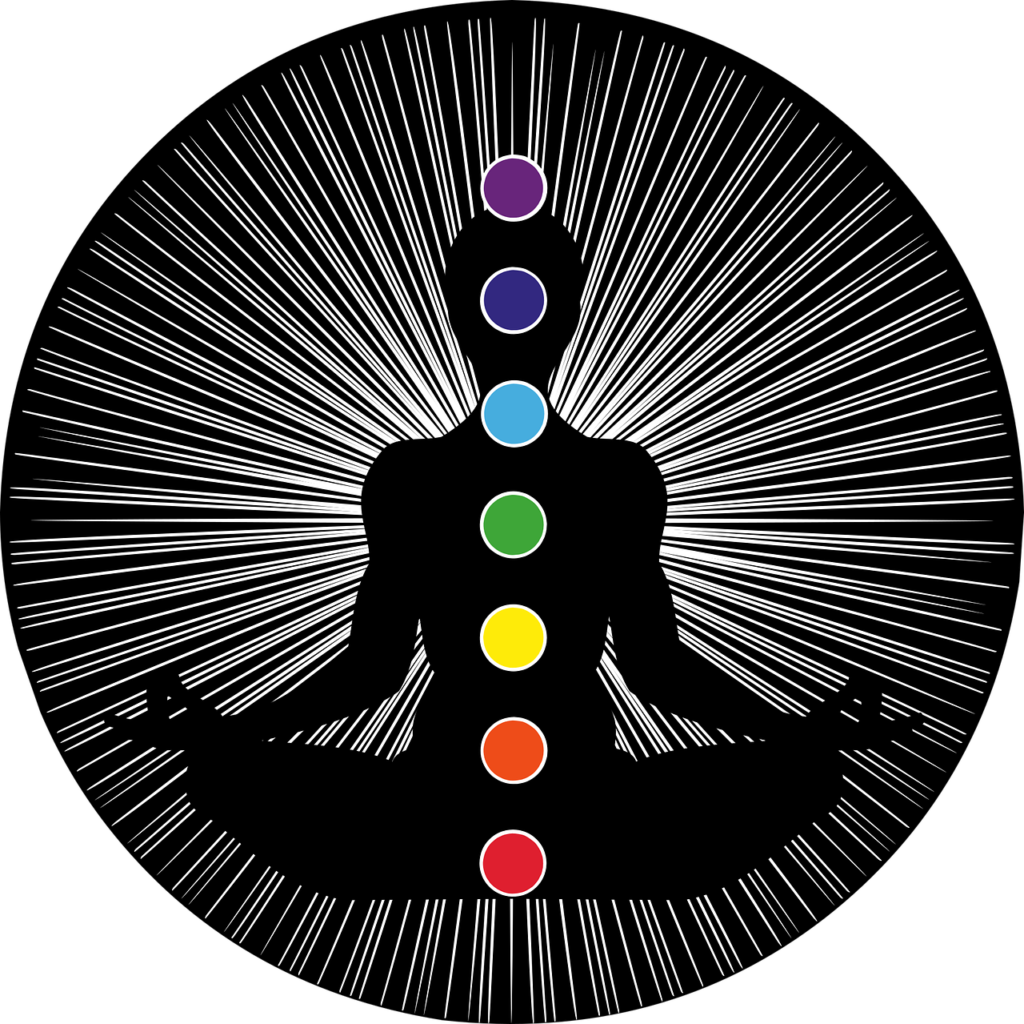
*Please note that I am not an affiliate or an ambassador of Sunlighten!
Sauna after-care
During your infrared sauna session, you perspired a boat load of sweat so, you absolutely must rehydrate with water and replenish electrolytes. Ummm, remind me what electrolytes are again? Electrolytes are simply minerals (sodium, magnesium, chloride, potassium, calcium and phosphorus) that carry an electric charge. Electrolyte-charged drinks are popular but you can also restore mineral levels through diet (bananas, mushrooms, pumpkin seeds, tofu)

You might also consider gently assisting your body with the detox process by taking a magnesium soak (you’ll need 1-2 C of flakes per tub or ½ C for foot soak). As mentioned above, this activity will also restore magnesium levels, an important electrolyte. Furthermore, most folks living in the US are magnesium deficient and you can read more about it in my earlier blog post here.
I recommend magnesium flakes as they are more readily absorbed by the body. If you don’t have a tub, you can simply soak your feet and still gain the benefits of magnesium. Here’s a source for a non-plastic soaking basin. When shopping for magnesium flakes, I suggest that folks consider purchasing from a Tibetan source as Dead Sea products are increasingly becoming contaminated and scarce.
If you don’t have time to apply magnesium, you can skip right to showering to ensure you wash away the toxins released through your skin during your sauna session.
Once you’ve experienced the deeply healing benefits of infrared sauna for weight loss, relaxation, or otherwise, I encourage you to keep up the practice as time and finances allow. At ~$30 per session, this gentle yet effective non-pharmaceutical is beyond a luxury, it is preventative medicine that you can take alone or with a companion. Go ahead, sweat your way to optimal health!
CAUTIONS
Like with trying anything new, start low and slow. A good place to start is at 110℉ degrees for 5-10 minutes and slowly increase up to 140℉ (only if it feels comfortable) and not exceeding 30 minutes.
Do not use a sauna if:
- You are pregnant
- You are trying to conceive as high heat can interfere with sperm health
- You have been exposed to heavy metals
Hydrate! You will need to replace the water you sweat out during the sauna so bring a bottle of water into the sauna with you. You also want to assist the body in flushing away the toxins that have been released, so continuing to hydrate after sauna is important too.
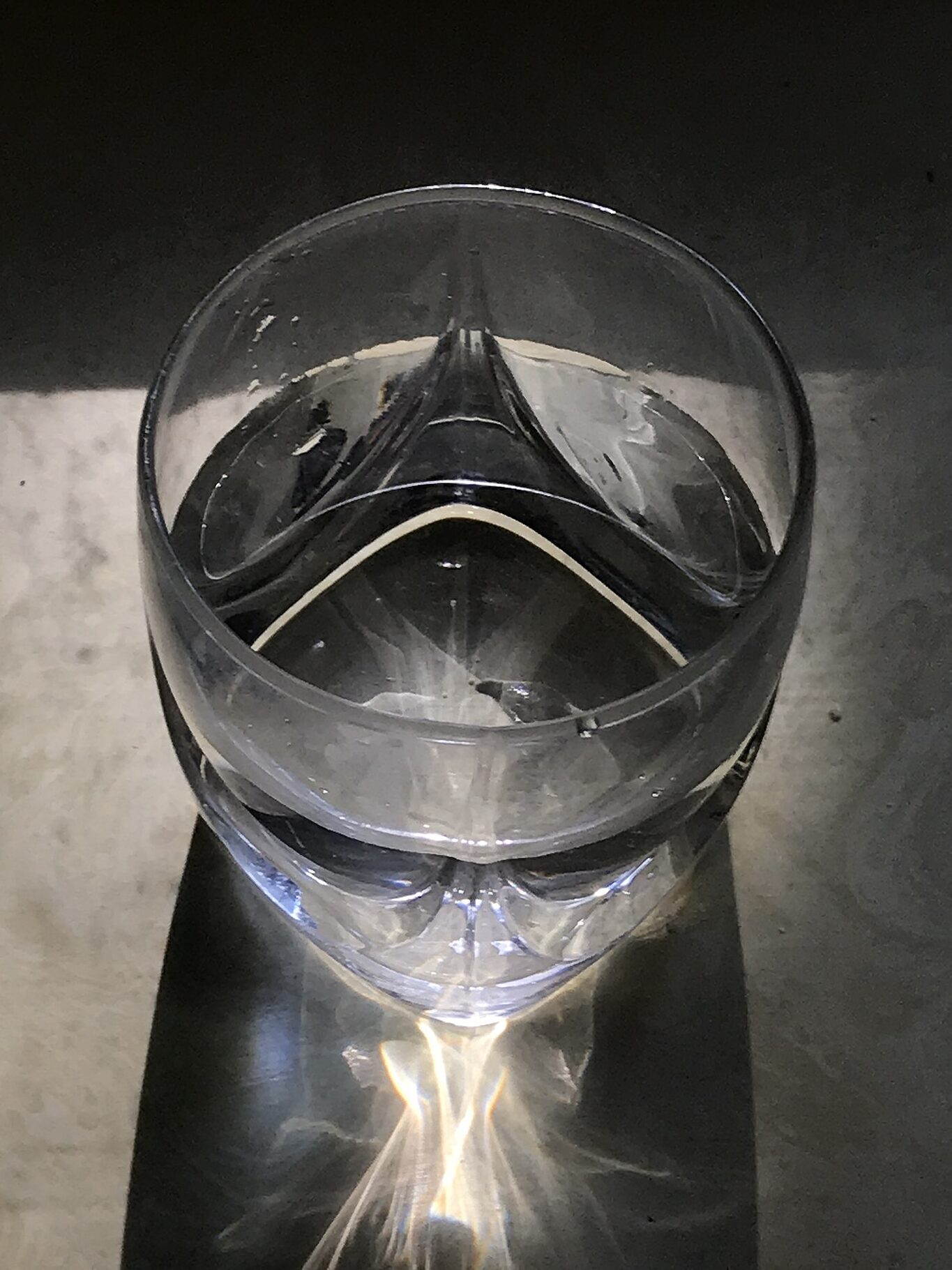
Disclaimer
The contents of this article are provided only for informational purposes and not offered as any medical claim, medical advice, treatment, cure, or prescription and I encourage you to conduct further research on anything you read here.
References
1. Yong, Ed. Photographing the glow of the human body National Geographic. July 20, 2009.
2. Partridge, Linda and Gems, David. Stress-Response Hormesis and Aging: “That which Does Not Kill Us Makes Us Stronger” Cell Metabolism, March 7, 2008.
3. Henderson, N. Kaemmer, Killen, G. Lauren, O’Neal, K. Eric, Waldman, Hunter S. The Cardiometabolic health benefits of sauna exposure in individuals with high-stress occupations. A mechanistic review: National Library of Medicine. Feb 18, 2021.

